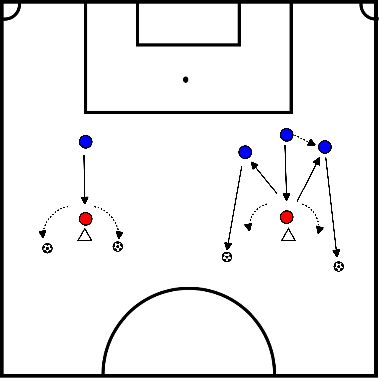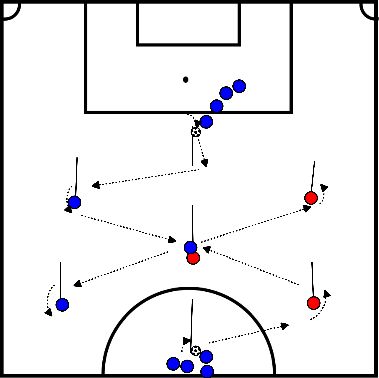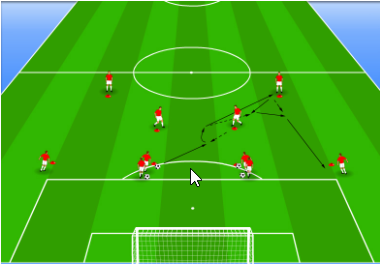Soccer drills
- Player 1 plays the ball to player 2.
- Behind player 2 is a defender.
- Player 2 turns left or right.
- Same as above but player 2 bounces back on player 1 who turned right (or left) and sprints away.
- Player 1 passes the ball in his feet.

Duration: +-10 min
- Execution:
- 1 ball per pair
- Ball in the middle
- Both players one step behind
- Players move forward at the same time so that the foot comes next to the ball
- With the other foot they kick the inside as hard as possible against the ball
- Number
- 10 times 5x right
- 5x left
- Then change partners
- Coaching moment:
- Don't hold back dare to kick
- Kick against the heart of the ball
- Ball in hand:
- Each time in front of the stick throw and catch ball.
- Throw center to center along the short side.
- Then third stick again the same as the first step.
- Ball in foot:
- Tap ball with left before stick and control it after the stick.
- Center pass along the short side.
- Then third stick again the same as first step.
- Coaches:
- 3 x stick yellow and 3 x stick red.
- In the middle yellow and red next to each other.

- Walk over the field in 2 numbers.
- Both players hold one end of a rope (1.5 meters).
- Once the attacker determines the pace and direction.
- As soon as the rope is released when it comes to tension, the attacker has a point.
- Defender may only hold the rope loosely.
- Divide the amount of players among equal teams.
- For example 3 teams of 3 or 4 teams of 3.
- Give each team its own coloured jacket.
- These teams compete against each other in 1 field.
- The first team to score is one round ahead.
- All players jog in over the field (square)
- Half the number of players has a ball
- players with ball pass the ball to a player without ball (eye contact).
- The players are not allowed to keep the ball with them for longer than 5 sec.
- At the moment the trainer whistles (signal), all players without a ball sprint as fast as possible to the closest player who has a ball and try to take it away.
- The player who has the ball should try to fence it off. (1:1 duel)
- When the trainer blows the whistle again we switch back to jogging and passing!
Nice variant is when you have an odd number of players, the player who can't find a direct opponent gets a command (for example sprint over the width of the field).
- Players face each other briefly in pairs.
- On the ground between the two players lies a ball.
- Trainer gives the commands:
- Head,
- chin,
- knees,
- feet,
- ears,
- BALL!
- On the command BALL! the players must try to get the ball as fast as possible.
- On the other commands they tap the corresponding body part
- You can use this exercise if you want to work in positions with a defensive triangle.
- You can apply variations where necessary and also change the distances.
- This exercise has been given several times with youth teams as well as with the first teams.
- As you can see in the picture we work on 2 sides.
- Approximately the space from the 16m to the center line.
- First player plays the ball diagonally, player B turns with the ball and plays it to C who performs a 1/2 with B. C plays the ball deep on D. It connects to the other group.
- When A is past the zone the other group leaves.
- Passing on A-B-C-D.
- You can also replace player D by a goalkeeper.
- You can do enough variations in this warm-up exercise. An extra 1/2 for player D. Or player B who moves on the pass of C and responds to D. And so on.
- Let the exercise run for about 4 minutes before inserting a variation.
- Always emphasize the forward rotation of B.
- Take care of a short passing and a short acceleration after the pass at the end of the warming up.

- The players line up in a circle,
- Ideal is 6 to 8 players per circle.
- Per circle you only have one ball.
EXECUTION:
- A player plays the ball to another player, chasing the ball towards the player he is playing.
- The second player receives the ball and plays it back to another player in the circle,
- He, too, will chase the ball towards the player he has just played in.
- This keeps repeating itself.
QUALITY:
- Passes must be clear and accurate.
- The passes are played over the ground, keep the ball low!
- Just after the pass the players accelerate (short sprint)
- Players call the name of the player they want to play in
- All players constantly stand on their toes, not on flat feet, to improve the speed of action.
PROGRESS:
- You can make the game more difficult by hitting once.
- You can play with two balls
- Player 1, who has given the pass, should try to tap the player who has played the pass (player 2) before playing the ball to player 3, etc.
- 3 lines a few meters apart.
- Each line has a name (apple pear or banana).
- The children start on a line.
- Trainer calls a fruit and the children must run to that line as fast as possible.
Exercise1 RUN STRAIGHT FORWARD
- Jog to the last pylon.
- Make sure your upper body is upright.
- Your hips, knees and feet should form a line.
- Don't let your knees buckle inwards.
- On the way back, run a little faster.
- Do the exercise twice.
Exercise 2 RAISE KNEE AND TURN UPPER LEG OUTWARDS WHILE RUNNING
- Jog to the first pylon.
- Stop and raise your knee forward.
- Turn your knee out and put your foot down.
- Keep your pelvis horizontal and your upper body still.
- The hip, knee and foot of the supporting leg together form a straight line.
- Do not let the knee of the supporting leg bend inwards.
- Jog to the next pylon and repeat the exercise with the other leg.
- When you have finished the course, jog back. Do the exercise twice.
Exercise 3 RAISE KNEE AND TURN UPPER LEG INWARDS WHILE RUNNING
- Jog to the first pylon.
- Stop and raise your knee sideways.
- Turn your knee inwards and put your foot down.
- Keep your pelvis horizontal and your upper body still.
- The hip, knee and foot of the supporting leg together form a straight line.
- Do not let the knee of the supporting leg bend inwards.
- Jog to the next pylon and repeat the exercise with the other leg.
- When you have finished the course, jog back.
- Do the exercise twice.
Exercise 4 RUNNING AROUND A PARTNER
- Jog to the first pylon.
- Shuffle sideways, at an angle of 90 degrees to your partner, shuffle a whole circle around each other (without changing your direction of view).
- and back to the first pylon.
- Bend your hips and knees slightly and move your body weight to the ball of your feet.
- Do not let your knees bend inwards.
- Jog to the next pylon and repeat the exercise.
- When you have finished the course, jog back.
- Do the exercise twice.
Exercise 5 JUMP AND TOUCH SHOULDERS WHEN RUNNING
- Jog to the first pylon.
- Shuffle sideways, at an angle of 90 degrees to your partner.
- Jump in the middle towards each other to make shoulder to shoulder contact.
- Land on both feet with your hips and knees bent.
- Do not let your knees bend inwards.
- Shuffle back to the first pylon.
- Jog to the next cap and repeat the exercise.
- When you are ready with the course, jog back.
- Do the exercise twice.
Exercise 6 RUN ACCELERATING AND SLOWING DOWN
- Run quickly to the second pylon
- and then run backwards to the first pylon;
- keep your hips and knees slightly bent.
- Always run two pylons forward and one back.
- When you're done with the course, jog back.
- Do the exercise twice.
Set up your team in 2 lines (4-5 per line max) - only 1 ball needed.
IMPLEMENTATION:
- Players take the ball and then play it to the first person in the line opposite to them. Immediately after the pass they draw a sprint and close the back of the line they just played in. This is repeated over and over again.
QUALITY:
- Players are all on their toes ready for the pass.
- Passes are clear and accurate.
- Players must shout if they want the ball to play, and also shout the name to whom they are passing again.
- With the first ball contact they bring the ball under control, the second ball contact is the pass to the other player.
PROGRESS:
- Apply only one pass.
- Let one line pick up the ball and throw it back to the other line. They will then play the ball back with a volleypass and then simply join the other line.
- Let players take the ball with their thigh and bring it under control after which they pass the ball back over the ground.
- Place a pawn 5 meters on either side of the central point between the 2 lines. After the pass, the players have to walk around the pawn after which they connect in the row.







